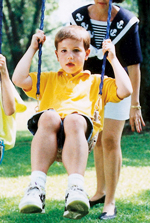Average Age That Babies With Muscular Dystrophy Walk
Signs and Symptoms
 Weakness related to Duchenne muscular dystrophy (DMD) selectively affects the limb muscles close to the body before the ones far from information technology; the legs are affected earlier the arms. Growth velocity with DMD is typically slower than normal in the first years of life, leading to short stature.
Weakness related to Duchenne muscular dystrophy (DMD) selectively affects the limb muscles close to the body before the ones far from information technology; the legs are affected earlier the arms. Growth velocity with DMD is typically slower than normal in the first years of life, leading to short stature.
Boys with DMD are oftentimes late walkers.
Variations in the gene LTBP4 and the regulatory region of the gene SPP1 are known to influence the age of loss of ambulation and/or the decay in muscle forcefulness.1,2,3,4,5 In toddlers, parents may notice enlarged dogie muscles (see prototype at right). This enlargement is known equallypseudohypertrophy, or "simulated enlargement," considering the muscle tissue is abnormal.Pseudohypertrophy can as well occur in the muscles of the thighs. Pseudohypertrophy can also occur in the muscles of the thighs.
A preschooler with DMD may seem clumsy and fall often. Parents likewise may note that children have trouble climbing stairs, getting upward from the flooring, or running. When arising from the flooring, afflicted boys may use hand support to push themselves to an upright position.
By school age, children may walk on their toes or the balls of their feet with a slightly waddling gait and fall frequently. To endeavour to keep their balance, they may stick out their bellies and pull back their shoulders. Children also have difficulty raising their arms.
Many children with DMD brainstorm using a wheelchair erstwhile by the age of 12. Transition to a wheelchair usually is a gradual process; at showtime, the chair may be required only to conserve the child's energy when covering long distances. Children often feel renewed independence once they fully transition to a power wheelchair.
In the teen years, activities involving the artillery, legs, or trunk may require aid or mechanical support.
Patients with DMD ofttimes die in their tardily teens or 20s from respiratory insufficiency or cardiomyopathy; but a few DMD patients survive across the third decade.
Pain and sensation
The musculus deterioration in DMD is non ordinarily painful in itself. Some people study muscle cramps at times; these usually can exist treated with over-the-counter pain relievers.
Because muscular dystrophy does non touch fretfulness direct, touch and other senses are normal, as is command over the shine, or involuntary, muscles of the bladder and bowel, and sexual functions.
The center
Lack of dystrophin can weaken the musculus layer in the heart (myocardium), resulting in a condition called cardiomyopathy, characterized by extensive scarring of the tissue. DMD also can crusade conduction abnormalities in the heart. It has been reported that all patients older than 18 present symptoms of cardiomyopathy. Over time, sometimes equally early on equally the teen years, the damage done by DMD to the heart can become life-threatening. The heart should be monitored closely, usually past a pediatric cardiologist. Come across Medical Direction for more than on cardiomyopathy in DMD.
Respiratory role
Serial monitoring of breathing chapters should first at the historic period of 5 or half-dozen. The diaphragm and other muscles that operate the lungs may weaken, making the lungs less effective at moving air in and out. Although a child may non complain of shortness of breath, problems that indicate poor respiratory role include headaches, mental dullness, difficulty concentrating or staying awake, and nightmares. Wheelchair-spring children tend to accept evidence of poor pulmonary function.
Weakened respiratory muscles brand cough difficult, leading to increased take chances of serious respiratory infection. A unproblematic common cold can speedily progress to pneumonia. It is important to become a influenza vaccine, and when infections occur, to get prompt treatment. Run into Medical Management for more than on respiratory intendance in DMD.
Learning
Near a third of boys with DMD have some degree oflearning disability, although few have serious cerebral disability. Doctors believe that dystrophin abnormalities in the encephalon may accept subtle effects on cognition and behavior. Learning problems in DMD occur in three general areas: attention focusing, exact learning and memory, and emotional interaction.
Children suspected of having a learning disability can be evaluated past a developmental or pediatric neuropsychologist through the school system's special instruction department or with a referral from an MDA Intendance Middle.
If a learning disability is diagnosed, educational and psychological interventions can brainstorm right away. A specialist may prescribe exercises and techniques that can help improve these areas, and schools as well can provide special assist with learning. See Medical Management for more about learning disabilities in DMD.
References
- Hightower, R. M. & Alexander, 1000. S. Genetic modifiers of Duchenne and facioscapulohumeral muscular dystrophies. Muscle and Nerve (2018). doi:10.1002/mus.25953
- Van Den Bergen, J. C. et al. Validation of genetic modifiers for Duchenne muscular dystrophy: A multicentre study assessing SPP1 and LTBP4 variants. J. Neurol. Neurosurg. Psychiatry (2015). doi:10.1136/jnnp-2014-308409
- Bello, 50. et al. Genetic modifiers of ambulation in the cooperative international Neuromuscular inquiry group Duchenne natural history written report. Ann. Neurol. (2015). doi:10.1002/ana.24370
- Flanigan, K. One thousand. et al. LTBP4 genotype predicts historic period of convalescent loss in duchenne muscular dystrophy. Ann. Neurol. (2013). doi:ten.1002/ana.23819
- Pegoraro, Eastward. et al. SPP1 genotype is a determinant of affliction severity in Duchenne muscular dystrophy. Neurology (2011). doi:10.1212/WNL.0b013e318207afeb
Source: https://www.mda.org/disease/duchenne-muscular-dystrophy/signs-and-symptoms
0 Response to "Average Age That Babies With Muscular Dystrophy Walk"
Post a Comment